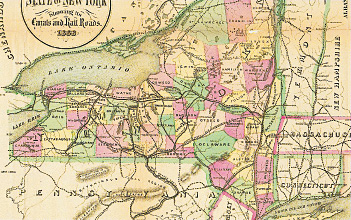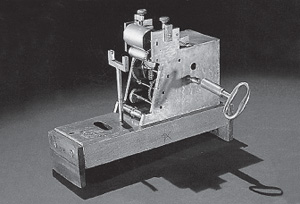 |
|||||||
|
The 1800's:
1
2
3
4
5
6
7
8
9
10
< previous
next >
The Tappan brothers became deeply involved in the abolition movement. Arthur founded the New York Anti-Slavery Society and later became president of the American Anti-Slavery Society. Lewis was even more committed to the cause. After an anti-abolition mob wrecked his house and burned his furniture in the street, he wrote to Theodore Weld, a fellow abolitionist, that he wanted his house to remain “this summer as it is, a silent anti-slavery preacher to the crowds who will see it.”
Hallock and Hale were determined that the JoC would always be the first to get the news coming in from outside New York. They soon gained another leg up on the competition by having their sloops land in Brooklyn outside the entrance to the harbor, where riders on horseback could speed the news dispatches and manifests to Wall Street. By 1833 the JoC’s stable of horses had grown to 26, with riders carrying dispatches in eight relays from Philadelphia, enabling the paper to publish news of Congress and all the news from the South a day before the competition. The other New York papers followed suit, and the U.S. Postal Service established its own express service from New York to Philadelphia. The JoC countered by extending its service to Washington, enabling it to regularly beat the government express by 24 hours. But the U.S. Post Office, ever jealous of its prerogatives, took the paper to court for violation of its monopoly on first-class mail and obtained a cease-and-desist order. The paper ended its equine news service, but that was not the last of its run-ins with the Post Office. This time, the JoC lost nothing, because the Post Office purchased its 26 horses for its own mail service to and from the capital.
Perhaps that was just as well, because technology was catching up with horse-borne news anyway. In 1838, the first steamship — the paddle- wheel steamer Sirius — steamed directly into New York harbor having crossed the Atlantic in 19 days. Four hours later the second one arrived, the Great Western, having crossed the ocean in only 14 days. And in 1844, Morse transmitted his famous first message, “What Hath God Wrought!” over a wire from Washington to Baltimore. In fact, Morse wrote his brother, he had the JoC’s newsgathering needs in mind when he cobbled together the separate inventions that he forged into the telegraph. Hallock, who was to be the dominant figure at the JoC until 1861, soon faced ever-stronger competition. One of the JoC’s compositors founded the city’s first penny newspaper, The Sun, and began to compete editorially with his alma mater. It was the first of New York’s “penny” papers, relying on its cheap price to build circulation against the city’s other papers, which, like the JoC, charged six cents. The six-penny papers responded by expanding their size, not in pages, but in the size of their pages, which became known as blanket sheets. The advent of cylinder presses had made it possible for publishers to print larger pages. The JoC set the record for blanket sheets in March 1853 with an 11- column page on a three-by-five-foot sheet of newsprint. It proclaimed itself “the largest daily paper in the world.” More competition emerged: The Courier merged with the Enquirer, gaining a circulation twice that of the JoC. And in 1835, James Gordon Bennett Sr. founded The Morning Herald, which was to become the city’s leading newspaper and the JoC’s strongest competitor. Hallock decided the paper needed a stronger circulation base, so in 1840, he merged it with the New York Gazette and General Advertiser. Founded in 1783, it was the city’s oldest newspaper and had published the Federalist Papers. Though the Gazette had a larger circulation than the JoC, Hallock elected to keep the JoC name, and within a year the Gazette’s name faded from the masthead. After the merger, the JoC gained the largest circulation of any of the six-penny papers. With the Gazette’s coverage of shipping and chemicals, the JoC expanded its business coverage to include finance, industry, transportation, politics and economics. It also covered general news, but always with an eye to the impact of major events on business, commerce and financial markets. The 1800's: 1 2 3 4 5 6 7 8 9 10 < previous next > |
||||||
| © Copyright 2005 United Business Media. All rights reserved. |
|||||||

